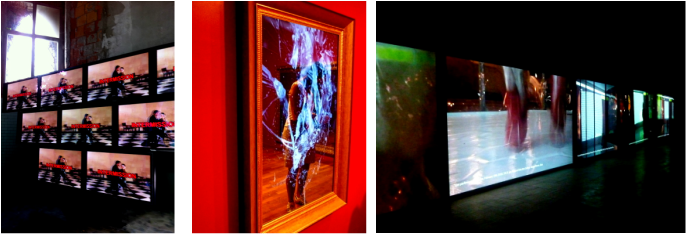 L-R Sturtevant, Lee Yongbaek, Ahmed Basiony L-R Sturtevant, Lee Yongbaek, Ahmed Basiony  Markus Schinwald Markus Schinwald At the 2011 Biennale, video was used to great effect in a number of the pavillions and individual exhibition spaces. In some cases, such as in the work of Sturtevant and Basiony (the latter representing Egypt), the use involved multiple screens of repeated and related imagery culled from alternate sources, or cut and edited so much that its original context that it didnt seem immediately relevant, whilst in the Korean and Austrian pavillions, video complemented other pieces and exhibition designs which were forward thinking and exciting to partake. In each of these exhibits, the white cube no longer exists. In the Korean pavillion, Lee Yongbaek covered much of the walls with wall to ceiling glass panels, completely covered in his floral photography. In the Egyptian pavillion, utter darkness aided only by the illumination of five oversized video screens held sway, whilst in the Austrian pavillion, a maze was constructed, rising up from knee length to ceiling, forcing visitors to scurry through narrow hallways to find Schinwald's hidden paintings and obscured furniture parts (before culminating in twin video screens at either side of the pagoda). In Lee Yongbaek's The Love Is Gone, But The Scar Will Heal, a sort of amalgamation of a number of the artist's series, juxtapositions of opposing imagery powered his video performances and the overall installation. On entering the Korean pavillion, the bulk of the work centred around Broken Soldier, a series of images which contrasted images of military types whose camoflauge was stamped into floral patterns. These disparate images were accompanied by another series, Pieta, taking their initial inspiration from the Italian tradition, but enlarging them to huge proportions. Providing a natural focal point for the exhibition, this series of works seemed to communicate well with the wider attempt of the exhibit. Pieta: Self Death is modelled on the well iconographic Madonna and Jesus, whilst at the opposite end of the exhibition, Pieta: Self-hatred displays two oversized modelled figures hellbent on the act of destruction. The destruction theme is taken up again in the series of Broken Mirror in which ornate, gold leaf style frames house mirrors, which then transform into screens where violence is enacted on the mirror surfaces. The video performance then, continually reinforces Lee's interest in conflict and resolution, all within a greater humanist/religious context. Throughout this exhibition, control meets destruction, restraint meets combat. The Arab Spring isn't often referred to throughout the Biennale. Often, mostly European nations take swipes at modern Islamic culture through a Western lens, but in Egypt's pavillion, the violence and conflict which seemed to power the Korean pavillion takes on another significance. Ahmed Basiony was a multimedia artist, whose work included performance art, music, and digital art. Footage of 30 Days Running in the Space, a conceptual, performance piece he carried out in 2010 at Cairo's Opera House and Palace of the Arts, is accompanied by his own footage of the riots and demonstrations in Tahrir Square that captured the world's attention in January 2011. Sadly, Basiony was caught up and killed by security forces during the uprising, just days after it began. Unlike the Korean pavillion, here, within the walls of the Egyptian pavillion, the violence was not theoretical or a musing on human behavior, but instead, a poignant and moving demonstration strongly rooted in reality and, coming just months after Basiony's death, utterly current. Whilst the dedication to Basiony is highly personalised, Austria's Markus Schinwald presents the human condition in a completely different manner. On partnering video screens, located at either end of the pavillion, a 9 minute film features five anonymous characters, who are reduced to the sum of their movements. Devoid of personality, they appear to be like dolls that have come to life; mute, struggling with basic movements of their limbs, and trapped in a series of repitition and drills. Shot in what seems to be an abandoned industrial site, the video, complete with a narrator is fascinating, and brings into focus the artist's fascination with legs; the claustrophobic, slightly inhuman element to the exhibit comes together with the video as viewers eventually realise that their participation, their searches through the labirynth, have been rewarded. The production values of Markus Schinwald's project, helped by Austria's healthy biennale budget (400,000 euro), couldn't be more different than those found outside Giardini. At Arsenale, Elaine Sturtevant, one of this year's recipients of the Golden Lion for Lifetime Achievement, showcased her work in a tiny outbuilding amongst Arsenale's old docks, and continued to challenge the idea of authorship and ownership, by editing a series of disparate filmed sequences into a furious, buzzing loop. I thoroughly enjoyed her work, particularly appreciating her decision to leave stock footage with its brand stamps, be they television channel insignias or software watermarks. I have some more of my highlights from the Biennale on the way, but more importantly, its significant to know how artists adapt the technology to their own needs and causes.
0 Comments
|
Dave
|
|
|
Dave Di Vito is a writer, teacher and former curator.He's also the author of the Vinyl Tiger series and Replace The Sky.
For information about upcoming writing projects subscribe to the mailing list. Dave hates SPAM so he won't trouble you with any of his own. He promises. |




 RSS Feed
RSS Feed